Discover 35 hidden attractions, cool sights, and unusual things to do in Fort Wayne (United States). Don't miss out on these must-see attractions: Fort Wayne Children's Zoo, Parkview Field, and Fort Wayne Museum of Art. Also, be sure to include Foellinger-Freimann Botanical Conservatory in your itinerary.
Below, you can find the list of the most amazing places you should visit in Fort Wayne (Indiana).
Table of Contents
Fort Wayne Children's Zoo
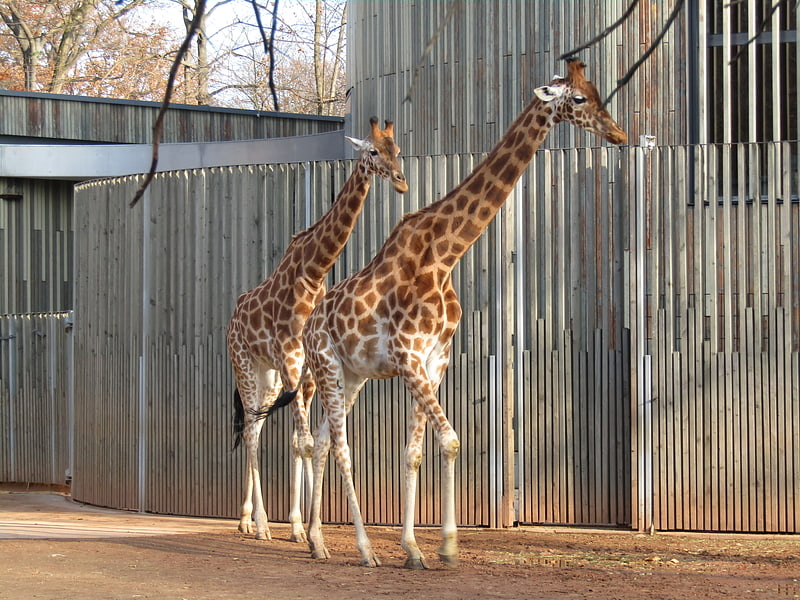
38 acres of international animals. The Fort Wayne Children's Zoo is a zoo in Fort Wayne, Indiana, United States. Since opening in 1965, the 1,000-animal zoo has been located on 40 acres in Fort Wayne's Franke Park. The Fort Wayne Children’s Zoo is operated by the non-profit Fort Wayne Zoological Society under a cooperative agreement with the Fort Wayne Parks and Recreation Department. The zoo receives no tax funding for operations and operates solely on earned revenue and donations
The zoo continuously ranks among the top zoos in the U.S. In 2015, TripAdvisor named it the seventh best zoo in the nation.[1]
Address: 3411 Sherman Blvd, 46808-1594 Fort Wayne
Parkview Field

Stadium in Fort Wayne, Indiana. Parkview Field is a minor league baseball stadium located in the central business district of Fort Wayne, Indiana, U.S.[2]
Address: 1301 Ewing St, 46802-3343 Fort Wayne
Fort Wayne Museum of Art
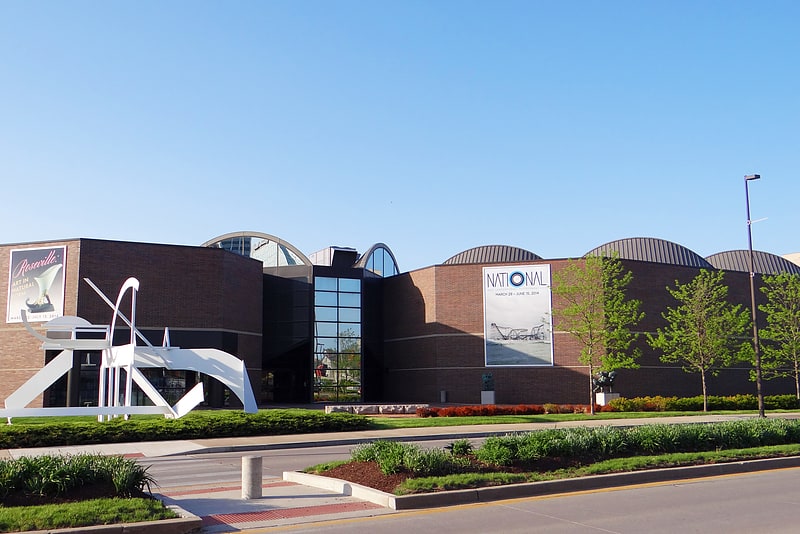
Museum in Fort Wayne, Indiana. The Fort Wayne Museum of Art is an American art museum located in downtown Fort Wayne, Indiana, Allen County, United States. The Fort Wayne Museum of Art contains permanent collections and national traveling exhibitions and is accredited by the American Alliance of Museums. FWMoA annually receives about 100,000 visitors.[3]
Address: 311 E Main St, 46802 Fort Wayne
Foellinger-Freimann Botanical Conservatory
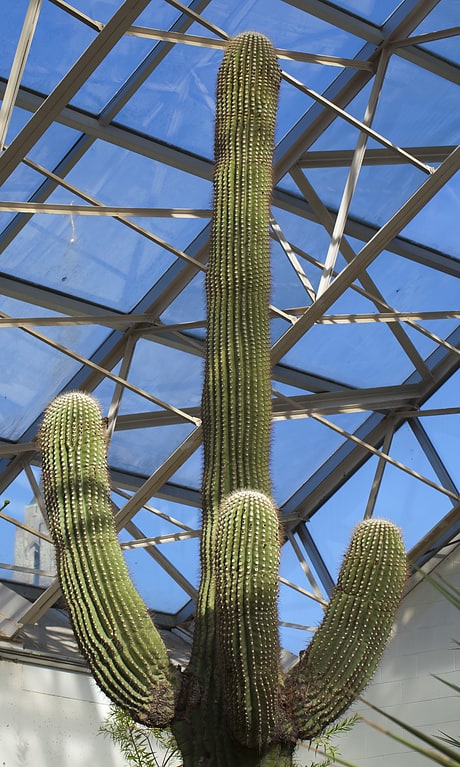
Botanical garden in Fort Wayne, Indiana. The Foellinger–Freimann Botanical Conservatory is an enclosed conservatory in downtown Fort Wayne, Indiana, United States. Opened in 1983, the conservatory contains a 25,000-square-foot seasonal showcase garden, a tropical oasis display, with a waterfall, Sonoran Desert display, and outdoor terrace and exploration garden, encompassing a total of 100,000-square-foot. The gardens display over 1,200 plants of 502 different species and 72 types of cactus.[4]
Address: 1100 S Calhoun St, 46802-3007 Fort Wayne
Cathedral of the Immaculate Conception
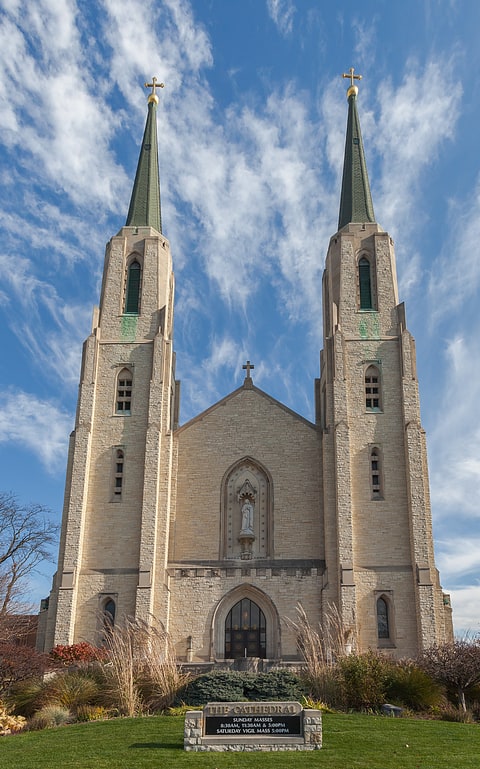
Cathedral in Fort Wayne, Indiana. The Cathedral of the Immaculate Conception in Fort Wayne, Indiana, is the primary cathedral of the Roman Catholic Diocese of Fort Wayne-South Bend, headed by Most Rev. Kevin Carl Rhoades. The parish was established in 1836, making it the oldest in Fort Wayne. The church was erected in 1860.[5]
Address: 1122 S Clinton St, 46802-3130 Fort Wayne
Science Central
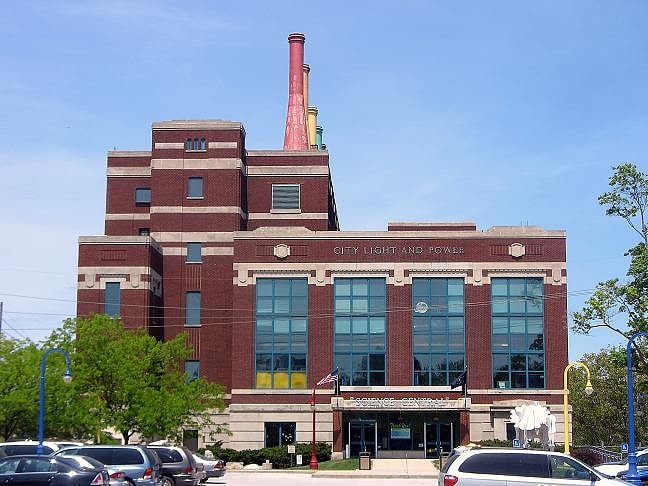
Science museum in Fort Wayne, Indiana. Science Central is an interactive science center in Fort Wayne, Indiana.[6]
Address: 1950 N Clinton St, 46805-4049 Fort Wayne
Embassy Theatre
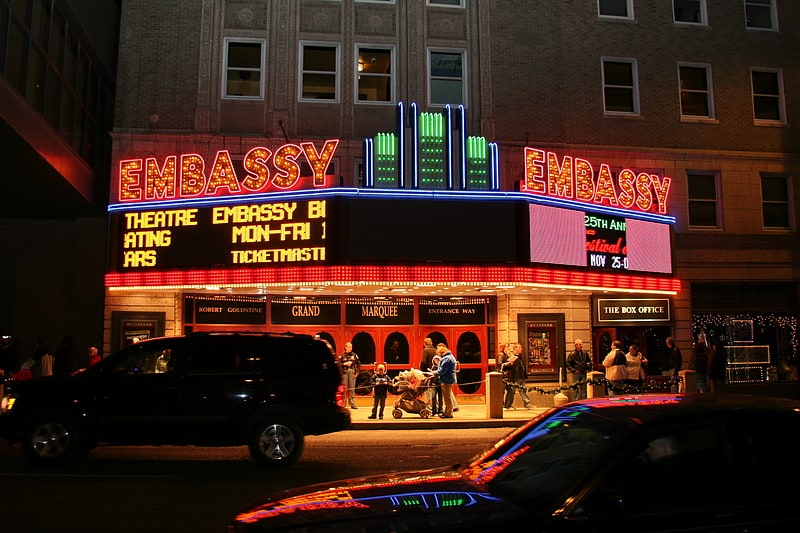
Theater in Fort Wayne, Indiana. The Embassy Theatre is a 2,471-seat performing arts theater in Fort Wayne, Indiana, USA. It was built in 1928 as a movie palace and today it is the home of the Fort Wayne Philharmonic Orchestra.[7]
Address: Fort Wayne, 125 West Jefferson Blvd
Grand Wayne Convention Center

Convention center in Fort Wayne, Indiana. The Grand Wayne Center is a convention center located in downtown Fort Wayne, Indiana, Allen County, United States. As a result of a $42 million renovation and expansion from 2003–2005, the Grand Wayne now encompasses 225,000 square feet.[8]
Address: 120 W Jefferson Blvd, 46802-3013 Fort Wayne
Allen County Courthouse

County court in Fort Wayne, Indiana. The Allen County Courthouse is located on Calhoun Street in the heart of Fort Wayne, Indiana, the county seat of Allen County. Built between 1897 and 1902, it is a nationally significant example of Beaux-Arts architecture. It was listed on the National Register of Historic Places in 1976 and was designated a National Historic Landmark in 2003.[9]
Address: 715 S Calhoun St, Fort Wayne
Johnny Appleseed Park
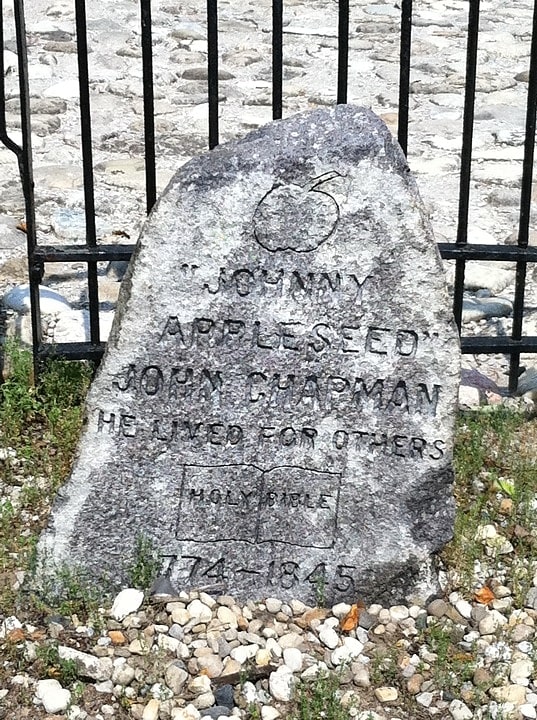
Park in Fort Wayne, Indiana. Johnny Appleseed Park, including what was formerly known as Archer Park, is a public park in Fort Wayne, Indiana. It is named after the popular-culture nickname of John Chapman, better known as "Johnny Appleseed", a famous American pioneer, who was buried on the site. Chapman's gravesite is accessible to public view through steel gates. The weathered tombstone says, "Johnny Appleseed He lived for others. 1774–1845." It also has a carved apple in bas relief.
It was listed on the National Register of Historic Places in 1973.
The land of the park was donated to Allen County, Indiana, by William T. McKay to serve as a memorial park for the community. It became part of the Fort Wayne Parks and Recreation Department as the city grew and annexed the land. Johnny Appleseed Park serves as the home for Fort Wayne's annual Johnny Appleseed Festival.
The current park, as of 2008, includes a large campground nestled in rolling meadows and woods along the St. Joseph River, Vietnam War Memorial, and at the extreme northwest corner of the park, includes the Allen County War Memorial Coliseum and Exposition Center.[10]
Address: Johnny Appleseed Park, 46805 Fort Wayne
McCulloch Park
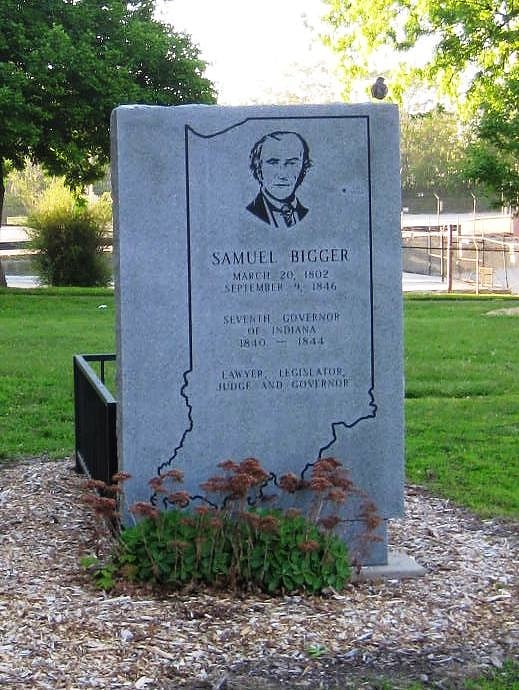
Park in Fort Wayne, Indiana. McCulloch Park is an urban park in the downtown area of Fort Wayne, Indiana. The park is named after former United States Secretary of the Treasury, Hugh McCulloch, who gave the land to the city for a park in 1886. The park is the burial place of Samuel Bigger, the seventh governor of the state of Indiana. The park features a large framed gazebo which was used for band concerts in the 1920s & 1930's. The park has a playground, featuring a swing set, a children's merry go-round, and slide. Once a year during the Three Rivers Festival, the park hosts an antique sale. The park is available by reservation for community functions. This park is adjacent to General Electric, which has been a part of the Fort Wayne economy scene for well over 100 years.[11]
Lincoln Bank Tower
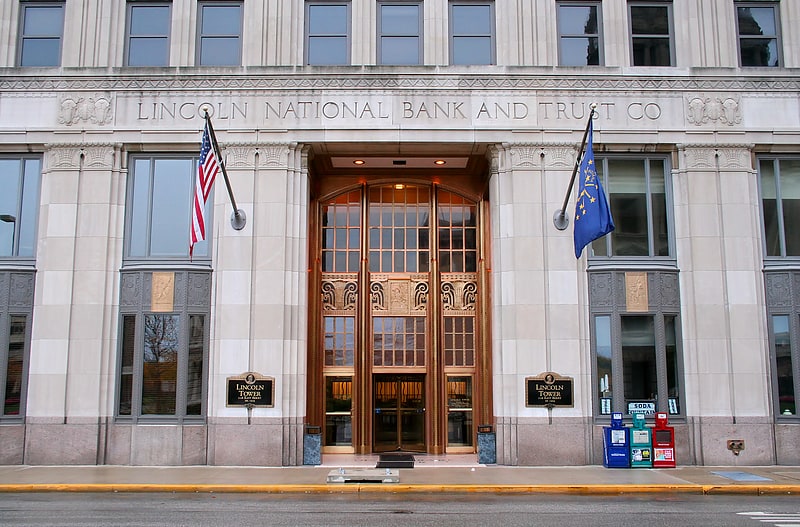
Building. The Lincoln Bank Tower in Fort Wayne, Indiana, United States, is an Art Deco highrise building. Construction started in late 1929 with the building's opening on November 16, 1930. For decades, it was the tallest building in the state. The building was also known as "Lincoln Bank Tower" to distinguish it from the building at 215 Berry Street, which had been known as the "Lincoln Life Building" from 1912 until 1923. Today, the other building is commonly known by its original name, the Elektron Building.[12]
Address: 116 E Berry St, Fort Wayne
Fort Wayne Old City Hall Building
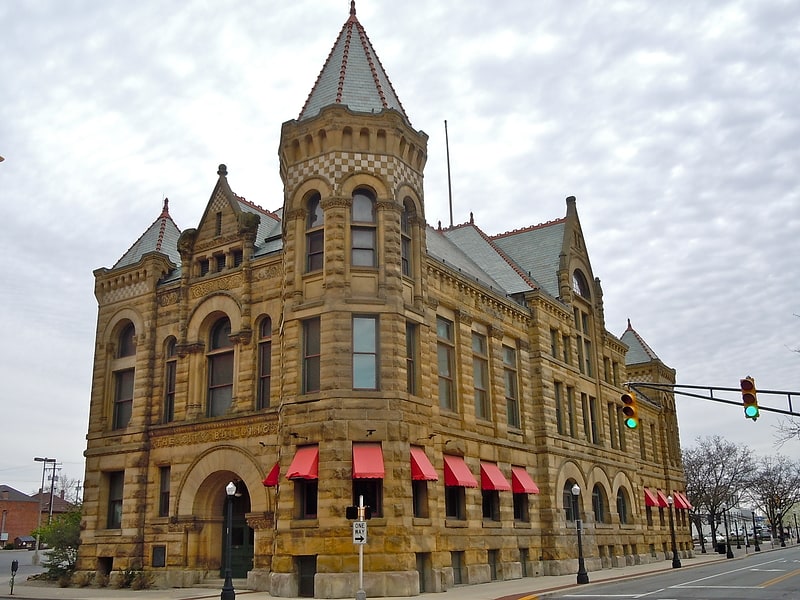
Building in Fort Wayne, Indiana. The Fort Wayne Old City Hall Building in downtown Fort Wayne, Indiana operates as a museum known as The History Center, and has served as headquarters for the Allen County–Fort Wayne Historical Society since 1980. The Richardsonian Romanesque style sandstone building was designed by the architectural firm Wing & Mahurin and built in 1893. It served as a functioning city hall for the city until 1971 when local officials moved to the City-County Building.
It was listed on the National Register of Historic Places in 1973.
The History Center has collected 27,000 artifacts in permanent displays dedicated to the region's history, dating from the Ice Age to the 18th century to present.
The Society also owns the National Historic Landmark Chief Jean Baptiste de Richardville House and the Historic Barr Street Market.[13]
Swinney Park
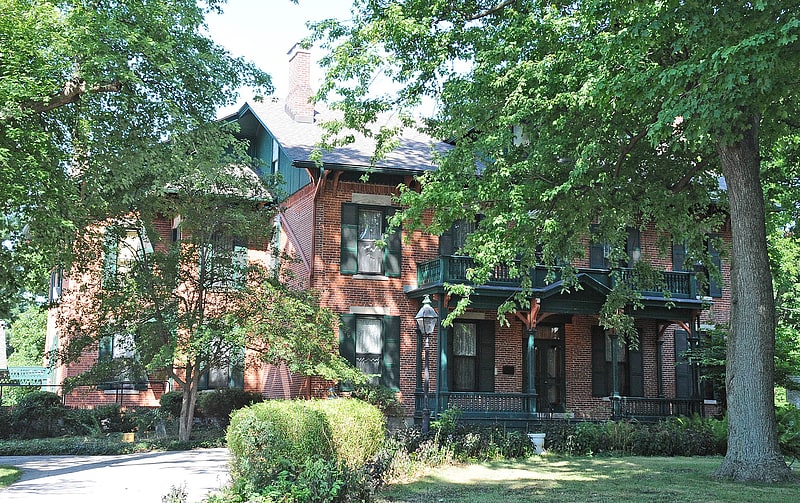
Thomas W. Swinney House, also known as The Swinney Homestead, is a historic home located at Fort Wayne, Indiana. It was built in 1844-1845 as a 1+1⁄2-story brick and limestone structure. It was enlarged with a 2+1⁄2-story, square, Late Victorian style brick wing about 1885. It features an Eastlake movement front porch. It was built by Thomas J. Swinney, a pioneer settler of Allen County and prominent Fort Wayne businessman. The house and land for Swinney Park were passed to the city of Fort Wayne in 1922.
It was listed on the National Register of Historic Places in 1981. It is located in the Fort Wayne Park and Boulevard System Historic District.[14]
Address: 1600 West Jefferson, 46802 Fort Wayne
John H. Bass Mansion

Building in Fort Wayne, Indiana. The Bass Mansion, also known as Brookside, is an administrative building and historic structure at the University of Saint Francis located in Fort Wayne, Indiana. The hand-carved, sandstone mansion was the private residence of industrialist John Henry Bass from 1902 to 1944. The Sisters of Saint Francis of Perpetual Adoration bought the home and more than 65 acres of surrounding landscape from the Bass family in 1944 and relocated their college. Since 1944, the mansion served as library and residence to the college.[15]
Address: 2701 Spring St, 46808-3939 Fort Wayne
Schmitz Block
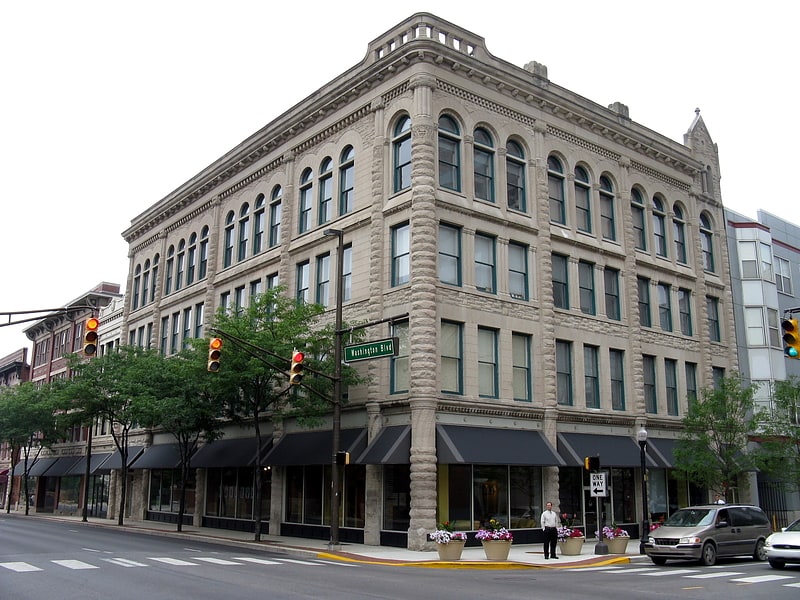
Schmitz Block, also known as the Noll Block, is a historic commercial building located in downtown Fort Wayne, Indiana. It was built in 1888, and is a four-story, "L"-shaped, Richardsonian Romanesque style brick building clad entirely in cut limestone. It features round rock-faced piers which extend the full height of the building and round arch windows. It was remodeled about 1912 after bring purchased by William F. Noll. For many years the building housed Hutner's Paris and Nobbson, a women's clothing store.
It was listed on the National Register of Historic Places in 1988.[16]
Fort Wayne
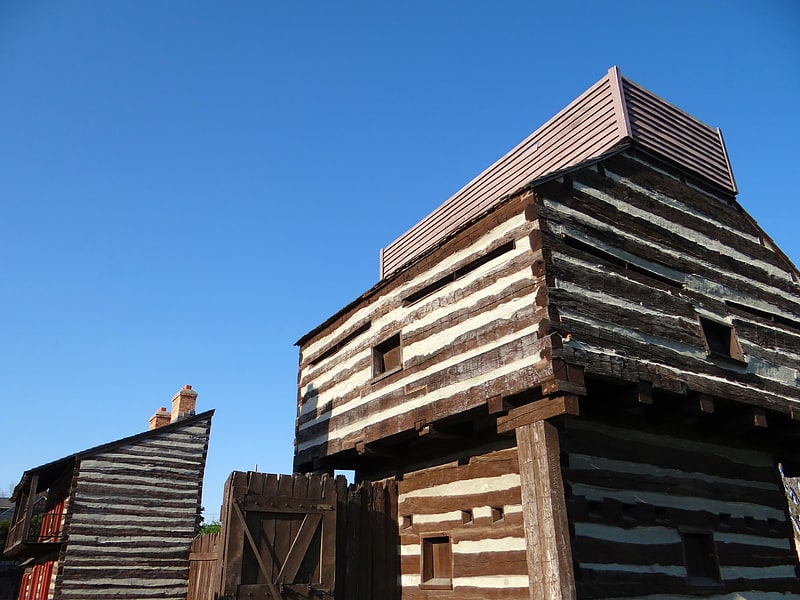
Fort Wayne was a series of three successive military log stockades existing between 1794 and 1819 in the Miami Indian village of Kekionga, on the portage between the St. Mary's and St. Joseph Rivers in northeastern Indiana, in what is now the city of Fort Wayne.
The first fort with that name was built in 1794 by Captain Jean François Hamtramck under orders from General "Mad" Anthony Wayne as part of the campaign against the Miami Indians during the Northwest Indian War. It was constructed to secure the territory gained in the Battle of Fallen Timbers, in which Wayne had recently been victorious, and was named after him. Wayne may have chosen the name himself—the fort was dedicated the day after he left it.
The fort was officially occupied by the US Army on October 21, 1794. It later saw service in the War of 1812. After the war, settlements started growing up around the fort. The fort was a basic stockade with few buildings. The original site was located near the present-day intersection of Berry and Clay streets.
The fort was abandoned in 1819 with the cessation of Indian hostilities, and the modern city of Fort Wayne was platted in 1823. A replica of the fort as it existed in 1815 (called "The Old Fort") was created in a different location in the city, and is now a tourist attraction.[17]
E. Ross Adair Federal Building and United States Courthouse
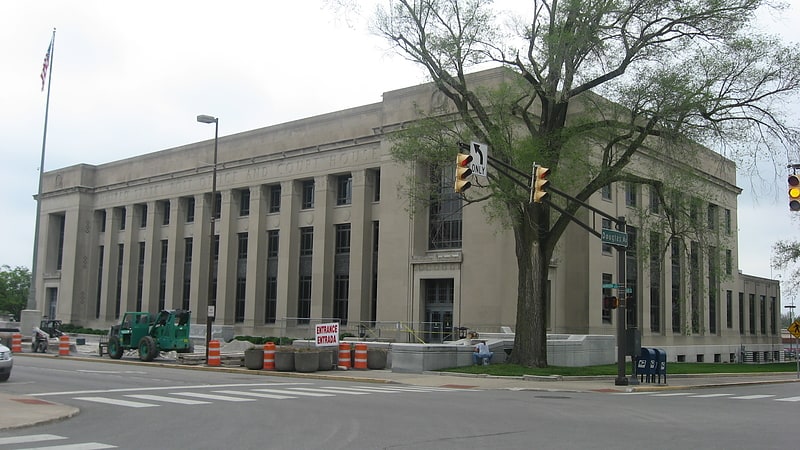
Courthouse in Fort Wayne, Indiana. The E. Ross Adair Federal Building and U.S. Courthouse is a historic post office, courthouse, and federal office building located at Fort Wayne in Allen County, Indiana. The building is a courthouse of the United States District Court for the Northern District of Indiana. It was listed on the National Register of Historic Places in 2006 as U.S. Post Office and Courthouse.[18]
Lindenwood Cemetery
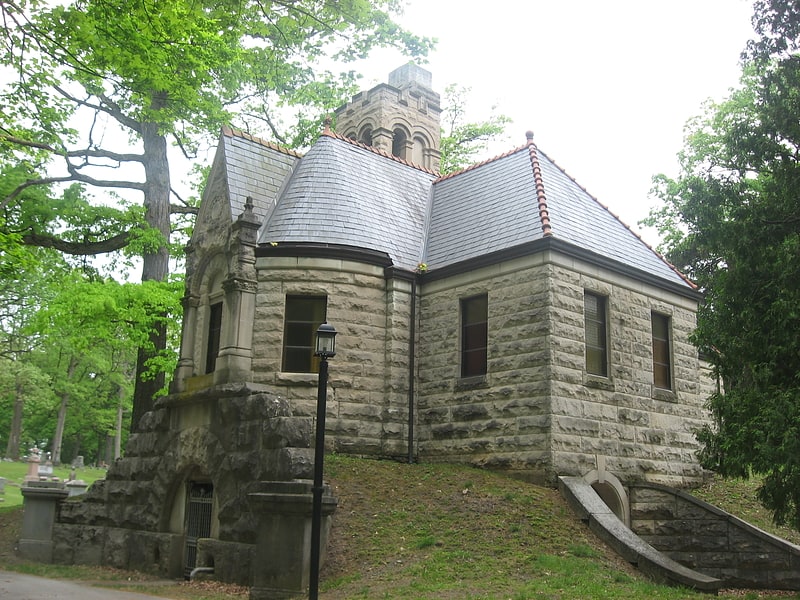
Cemetery in Fort Wayne, Indiana. Lindenwood Cemetery is a rural cemetery operated by Dignity Memorial in Fort Wayne, Indiana, established in 1859. With over 69,000 graves and covering 175 acres, it is one of the largest cemeteries in Indiana.
Famous interments include some of the most important political figures from Fort Wayne history including Samuel Hanna (1797- 1866), Jesse L. Williams (1807-1886), Allen Hamilton (1798-1864), Colonel George W. Ewing (1804-1866), Paul Frank Baer (1893-1930), Daisy E. Nirdlinger (1879-1950) and Arthur "Art" Roy Smith (1890-1926).
Isaac De Groff Nelson helped to incorporate Lindenwood Cemetery, where a monument was built to him.
Lindenwood was placed on the National Register of Historic Places on February 17, 1978.[19]
Address: 2324 W Main St, Fort Wayne
Randall Building
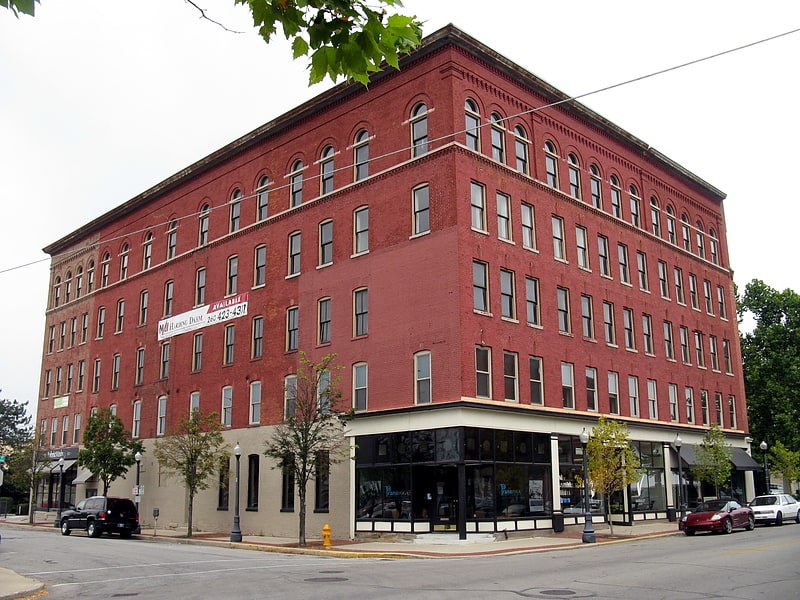
Randall Building, originally an extension of the Randall Hotel, is a historic commercial building located in "The Landing" section of downtown Fort Wayne, Indiana. It was built in 1905, and is a large five-story, Renaissance Revival style brick building. For many years the building was occupied by Seavey Hardware.
It was listed on the National Register of Historic Places in 1990.[20]
Arts United Center

Arts United Center is an arts center in Fort Wayne, Indiana, USA.
The Fine Arts Foundation of Fort Wayne originally proposed the construction of a large complex devoted to the arts in the early 1960s. The foundation compiled an ambitious program including facilities to support an art school, gallery, theatre, orchestra, historical museum. In 1961, a selection committee commissioned architect Louis Kahn to design the project based on referral from Philip Johnson.
Kahn's first plan, presented in 1965, incurred an estimated cost of $20 million, which far exceeded the $2.5 million allocated for the project. In response to financial limitations, the project's scale was limited to the performing arts facilities; The Theatre of Performing Arts is the only realized building in Kahn's design. Arts United (formerly Fine Arts Foundation) now cares for Arts Campus Fort Wayne, owning and operating the Arts United Center, Hall Community Arts Center, Auer Center for Arts and Culture, and Parkview Physicians Group ArtsLab. The cultural district also includes History Center, Fort Wayne Museum of Art, and Rankin House.
Arts United of Greater Fort Wayne is embarking on a strategic plan to bring the theatre up in renovation. The organization received $2 million from AWS Foundation on 2019 for accessibility.[21]
Embassy Theater
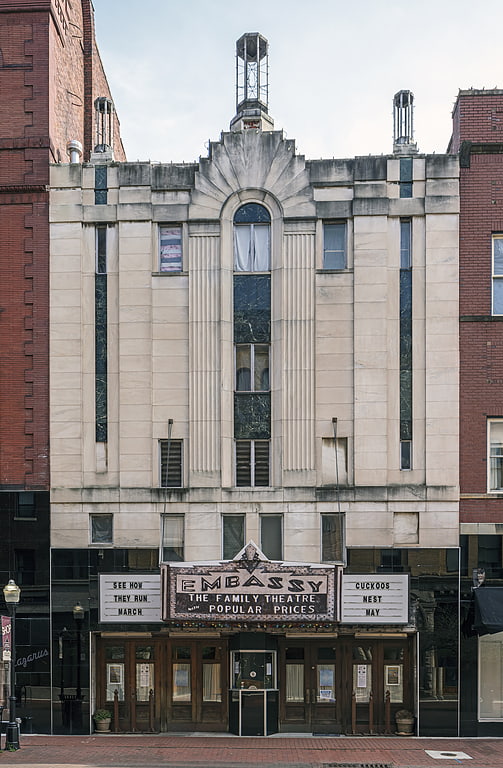
Theater in Cumberland, Maryland. The Embassy Theatre is a performance theater located in the downtown mall of Cumberland, Maryland at 49 Baltimore St. The theater mounts live performances of classic theatre fare such as Kurt Weill's Threepenny Opera and Kander and Ebb's Cabaret, as well as lesser-known work such as "The Mystery of Irma Vep" and "The Lady In Question," original works and local historical plays. Other entertainment presented at the theatre includes movies and musical concerts. Originally opened as a movie theater in 1931, it then became a curtain and drapery store, and finally was remodeled to a live performance theater and allied arts venue. Until December 2014, the theatre was operated as the New Embassy Theatre. Recently remodeled, it now operates as the Embassy Theatre.
The Embassy was designed by architects Hodgens and Hills in the Art Deco style. The building features prominent fluted pilasters, topped with finials illuminated with neon. The theater is a major contributing feature of the Downtown Cumberland Historic District.[22]
African / African American Historical Society Museum of Allen County

Museum, Specialty museum
Address: 436 E Douglas Ave, 46802-3539 Fort Wayne
St. Peter's Square
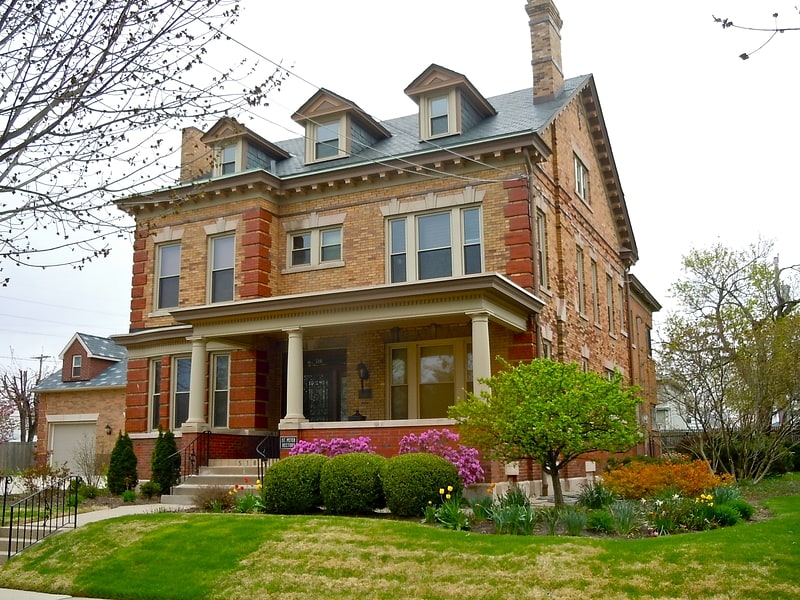
Catholic church in Fort Wayne, Indiana. St. Peter's Square is a historic Catholic complex and national historic district located at Fort Wayne, Indiana. The district encompasses five contributing buildings associated with St. Peter's Catholic Church. They are the Gothic Revival style St. Peter's Catholic Church, former St. Peter's School, boiler house, and the Colonial Revival style John Suelzer House and garage. The house serves as the church rectory.
It was listed on the National Register of Historic Places in 1991.[23]
Wells Street Bridge
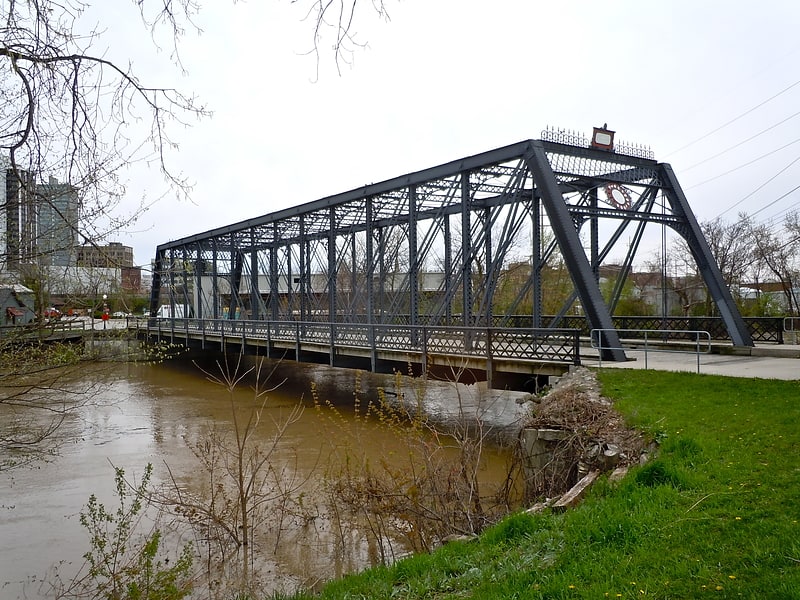
Truss bridge in Fort Wayne, Indiana. Wells Street Bridge is a historic Whipple truss bridge spanning the St. Marys River at Fort Wayne, Indiana. It was built by the Wrought Iron Bridge Company of Akron, Ohio and erected by Alvin John Stewart in 1884. It has a 180 foot long span and is 23 feet wide. It was closed to vehicular traffic in 1982 and used as a pedestrian walkway.
It was added to the National Register of Historic Places in 1988.[24]
Castle Gallery Fine Art
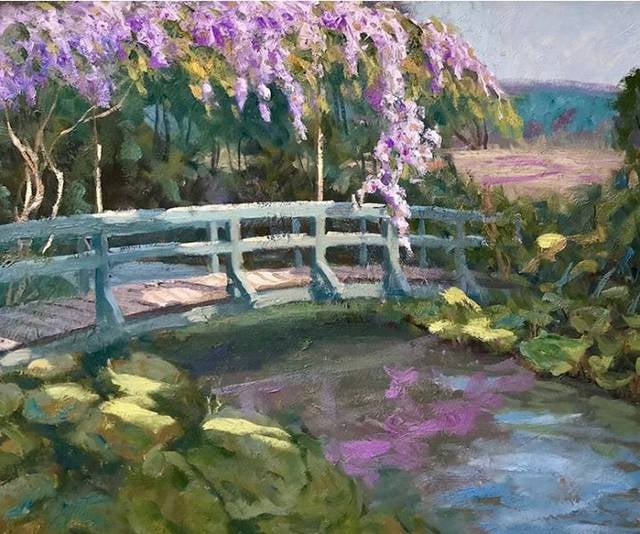
Museum, Forts and castles, Art gallery
Address: 1202 W Wayne St, 46802-5937 Fort Wayne
Indiana Michigan Power Center
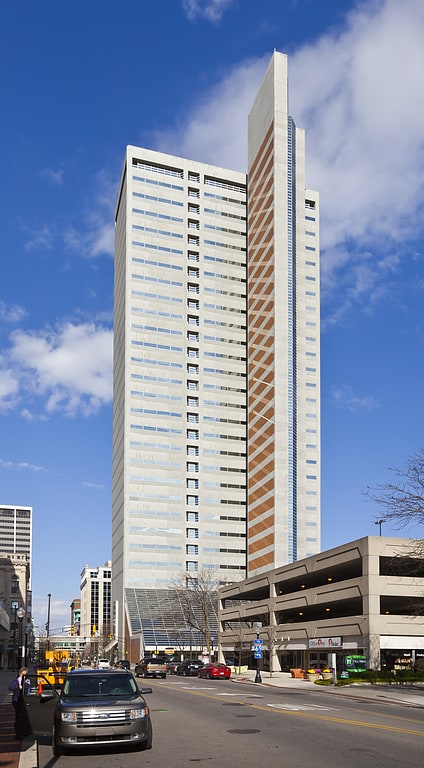
Building. Indiana Michigan Power Center, previously known as One Summit Square and also as the Summit National Bank Building after one of its original tenants, is the tallest office building in Fort Wayne, Indiana, United States, as well as the tallest reinforced concrete building in the state of Indiana.
The Indiana Michigan Power Center is a Modern 27-story building which stands at 134.7 m (442 ft). Designed by Kevin Roche John Dinkeloo and Associates, the building is unique in that it was built to give the illusion of two buildings, the adjoining tower housing the elevators.
The original plan called for a second 20-story office tower and a 9-story hotel that were never built. These towers were part of a larger superblock project in downtown Fort Wayne in the late 1970s. These projects also included the Grand Wayne Center, the Foellinger-Freimann Botanical Conservatory, the Hilton Fort Wayne, the Civic Center Parking Garage, and the renovation of the Embassy Theatre. Although many projects of the superblock were completed, Two Summit Square and Three Summit Square were canceled due to the financial difficulties of People's Trust Bank. People’s Trust Bank was forced to merge with Indiana Bank to form Summit Bank, which grew to cover the Indianapolis and north central Indiana areas prior to a sale to NBD Bank in 1992. The recession of 1981-1982 and a change in contractors midway through the project that led to cost overruns resulted in the completion of only one tower instead of the initially planned three. A plaza with trees and landscaping now occupies the land on which the other towers were to have been built, and is home to food trucks, community events, and farmer's markets.
Originally, the tenants of One Summit Square were electricity provider Indiana Michigan Power along with Summit Bank and its holding company Summcorp (the largest bank in Fort Wayne at the time). Through a succession of mergers, One Summit Square eventually became the Northeast Indiana market headquarters for JPMorgan Chase. However, Indiana Michigan Power is the largest tenant, occupying most of the top half of the building. Indiana Michigan Power gained naming rights to the building in 2014. Another major tenant is SIRVA, having moved their sizable Fort Wayne operations from their longtime home on US 30 in the fall of 2017. SIRVA occupies floors 5 through 11 of the building. In addition to local market and middle-market commercial banking offices on the first and second floors, JPMorgan Chase continues to maintain a Chase retail banking branch (with three ATMs) on the first floor. This branch was renovated in the fall of 2016; J.P. Morgan private banking offices were moved to an office in Indianapolis and six other Chase branches in the Fort Wayne area under the Chase Private Client offering. However, Chase Private Client was made available at this branch in 2020, tapping into the rise of the affluent locating downtown; the 2016 renovation allowed for this to be added. Barnes & Thornburg was a tenant until the spring of 2016 when Ash Skyline Plaza opened. Indiana Michigan Power Center is also home to other companies besides Indiana Michigan Power, SIRVA, and JPMorgan Chase.
The partnership that owned One Summit Square was to have ended in 2016, which would have required the tenants to find new homes. However, Hanning & Bean Enterprises, Inc. (now NAI Hanning & Bean) along with Simon Dragan and Pat Bruggeman purchased the building from the partnership in 2014 for $12 million, pledging $5 million in renovations. The new owners signed new long-term leases with both AEP and JPMorgan Chase. As a result of these changes, One Summit Square was renamed Indiana Michigan Power Center with added signage on the west and east facades of the building.
Until 2014, the thirteenth floor also housed the Window Garden Café, a Sodexo-managed cafeteria. The cafeteria reopened under the management of new owner Ceruti’s Catering in 2018, and once again in 2019 as NOLA on 13. While not a partner in the cafe, NAI Hanning & Bean also owns restaurants at 1st Source Center downtown, near Northcrest Shopping Center, and two restaurants at the Ramada Plaza Hotel on the city's north side.[25]
Journal-Gazette Building
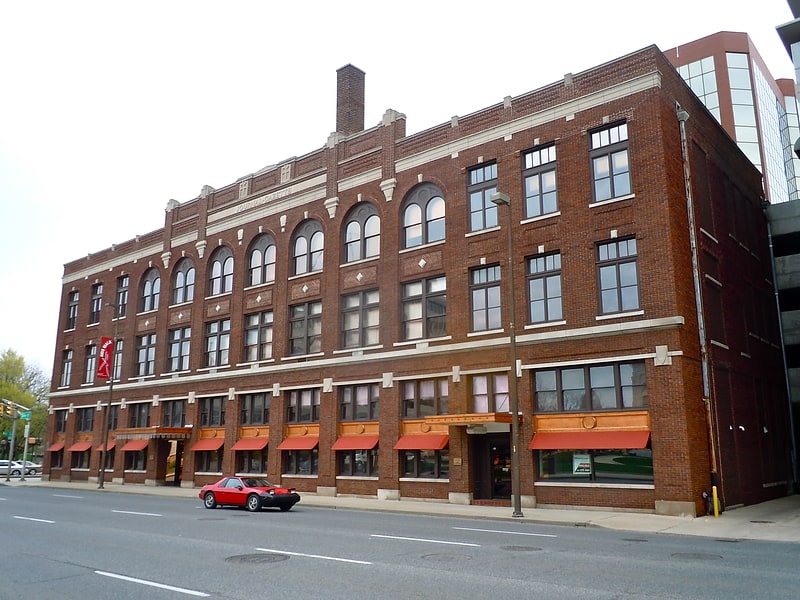
The Journal-Gazette Building is a historic commercial building located in downtown Fort Wayne, Indiana. It was designed by noted Fort Wayne architect Charles R. Weatherhogg and built in 1927–1928. It is a four-story, 13 bay, red brick building with limestone trim in the Chicago Style. The seven central bays feature round arch window openings. For many years the building housed The Journal Gazette newspaper plant.
It was listed on the National Register of Historic Places in 1982.[26]
McColloch-Weatherhogg Double House

Building in Fort Wayne. The McColloch-Weatherhogg Double House, also known as the J. Ross McCulloch House, is a historic residential building constructed in 1883 in the Victorian Gothic Revival style at 334-336 E. Berry St. Fort Wayne, Indiana. The building is now the home of United Way of Allen County and was listed on the National Register of Historic Places on December 7, 2001.
The house was built for banker Charles McCulloch, whose father Hugh McCulloch was Secretary of the Treasury under Presidents Abraham Lincoln, Andrew Johnson and Chester A. Arthur. Thomas J. Tolan is believed to have been the building's architect.
Charles' sons John Ross McCulloch and Frederick McCulloch eventually lived on both sides of the house. It was also the residence of prominent local architect Charles R. Weatherhogg.
The home was once on the Historic Landmarks Foundation of Indiana's 10 Most Endangered Buildings List and in disrepair. The Historic Landmarks Foundation restored the building and adjacent carriage house beginning in 2003. Fort Wayne businessman Jerry Henry purchased the home in 2005 and did his own rehabilitation of the structure for the United Way. Kelty Tappy Design supervised the rehabilitation and also developed and filed the paperwork for historic certification with the National Park Service.[27]
John Brown Stone Warehouse
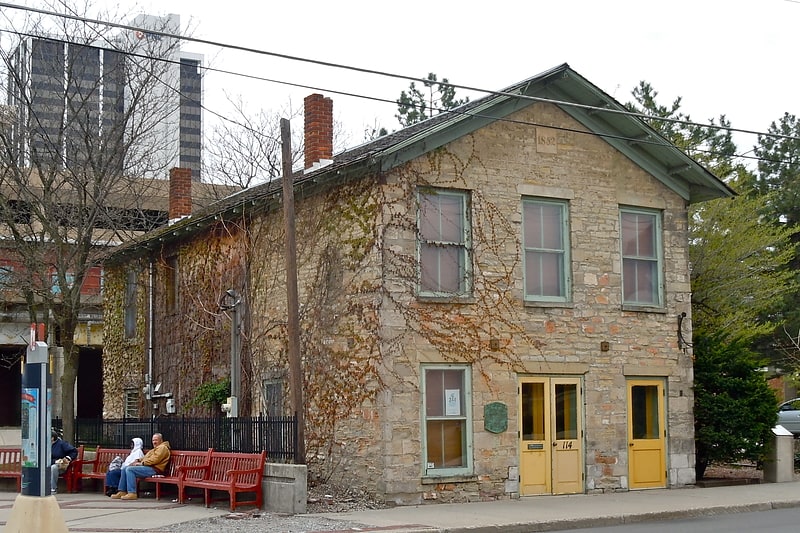
John Brown Stone Warehouse, also known as The Canal House, is a historic commercial building located in downtown Fort Wayne, Indiana. It was built in 1852, and is a two-story, three bay, gable front stone building. The building measures 22 feet wide and 50 feet deep. It was built by John Brown out of salvage and "waste" materials from his business as stone merchant and mason. It is the oldest commercial building in Fort Wayne and has been renovated to house offices.
It was listed on the National Register of Historic Places in 1997.[28]
Engine House No. 3

Engine House No. 3 is a historic fire station located in downtown Fort Wayne, Indiana. It was designed by the architectural firm Wing & Mahurin, with the original section built in 1893 and an addition built in 1907. It is a two-story, Romanesque Revival style red brick building. The building houses the Fort Wayne Firefighters Museum.
It was added to the National Register of Historic Places on July 27, 1979.[29]
Saint Paul's Evangelical Lutheran Church
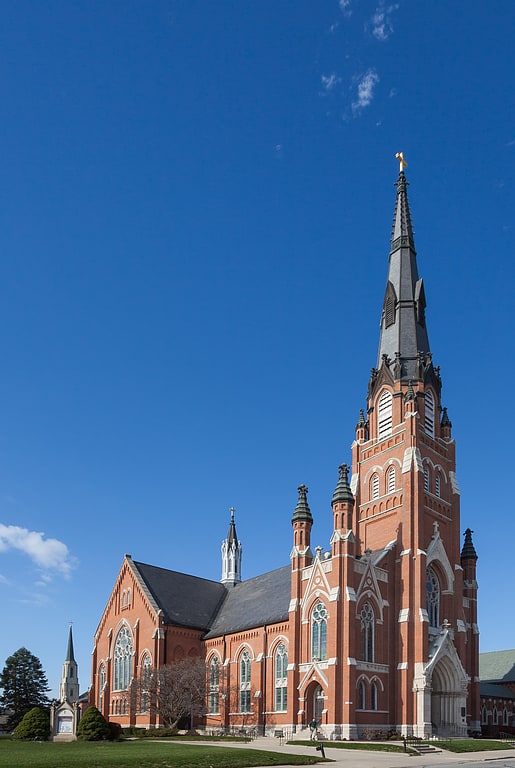
Lutheran church in Fort Wayne, Indiana. Saint Paul's Evangelical Lutheran Church is a congregation of the Lutheran Church–Missouri Synod located at the intersection of Barr and Madison Streets in Fort Wayne, Indiana. Founded in 1837, it is the second oldest Lutheran church in Indiana and the oldest in the northern part of the state. Thanks largely to its size and to the leadership of its pastors, it has long played a prominent role in Indiana Lutheranism and in the Missouri Synod as a whole.
The congregation's first sanctuary was constructed in 1839, built on the site of the present sanctuary. The congregation constructed a second, wood-frame church in 1847, building an addition to this structure in 1862. The present church was first completed and dedicated in 1889, but a 1903 fire forced a near-complete rebuild of the structure.
St. Paul's belongs to the Indiana District of the LCMS.
Ever since this first simple edifice was built, the congregation has maintained a house of worship on this spot, evermore enlarging its facilities to meet the demands of the growing membership. Thus, a second church building was provided in 1847, which building, however, soon became inadequate, making an addition necessary in 1862. Though two daughter congregations branched off to form new parishes during the next two decades, it again became necessary to provide more ample facilities."
It was designed by the architectural firm of Wing & Mahurin and is a High Victorian Gothic style church built in 1889. On September 15, 1889, a large church was erected. On December 3, 1903, there was a fire that left it in ruins. They began building it back up again, and in April 1905, they had gotten it back to its former glory. During the late 1940s it underwent renovation. Then it had modern improvements and enhancements as time went on. This grand church still exists today, along with the elementary school that accompanies it.
The church was added to the National Register of Historic Places in 1982.[30]
Richardville House
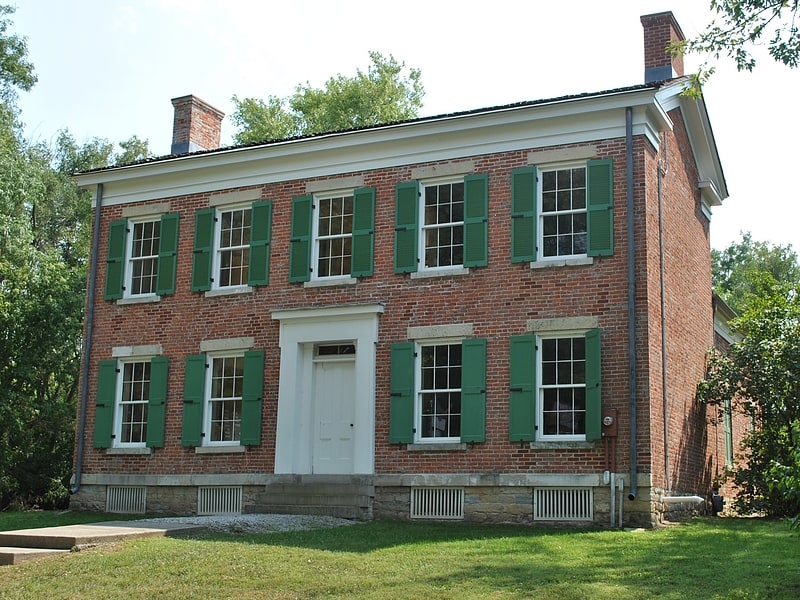
Historical landmark in Fort Wayne, Indiana. The Chief Jean Baptiste de Richardville House was built near Fort Wayne, Indiana, in 1827. Subsidized by the U.S. federal government through the 1826 Treaty of Mississinewas, it is believed to be one of only three treaty houses built east of the Mississippi River. It was designated a National Historic Landmark on March 2, 2012.[31]
Fort Miami
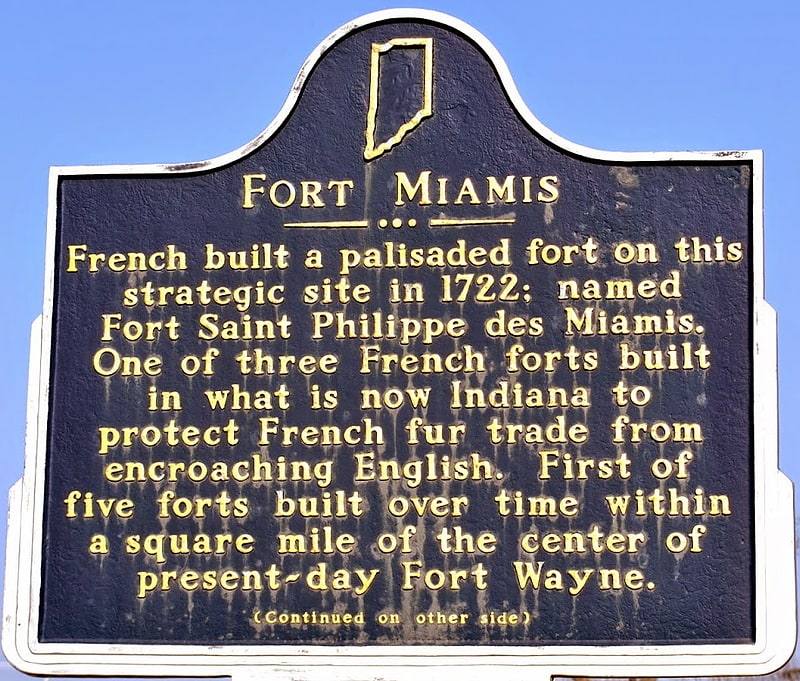
Fort Miami, originally called Fort St. Philippe or Fort des Miamis, was the name of a pair of French palisade forts built at Kekionga, a large Miami Indian village founded where the St. Joseph River and St. Marys River merge to form the Maumee River in northeastern Indiana, near the Ohio border.
In 1715, the French had located a trading post in the Miami capital village of Kekionga. The Miami refused to abandon their village and move farther West, away from encroaching British traders, so Governor Philippe de Rigaud Vaudreuil authorized Jean Baptiste Bissot to build a strong fort to protect the trade routes of New France. The first fort was built in 1722.
The original fort served as a successful trading post until 1747, when English-allied Huron warriors under Chief Nicholas found it undermanned—the commandant, Ensign Douville, and most of the soldiers were away at Fort Detroit. The fort was sacked and burned to the ground.
In Summer 1749, a force of French and Indians under Captain Pierre Blainville rebuilt the fort. This second fort survived the French and Indian War, but it was attacked in 1752, and two soldiers from the French garrison were caught outside the fort and killed. In November 1760, at the close of the French and Indian War, the French garrison formally surrendered Fort Miami to Ensign Holmes of the Kingdom of Great Britain. The British soon lost control of the fort in 1763, during Pontiac's Rebellion, and the fort was destroyed by the Indians.
The British refortified the town, and the trading post again became successful. It was sacked in 1780 by a force under Augustin de La Balme, a French cavalry officer who came to the new United States of America to assist with the American Revolutionary War. The force raided the stores, but was soon destroyed by Miami Chief Little Turtle, and the goods were returned. The coalition at Kekionga remained true to their British allies even after the area was ceded to the United States at the close of the war. It therefore became a target of American armies, leading to several noteworthy Indian victories now known as the Northwest Indian War. One such battle, Hardin's Defeat (1790), occurred within sight of the fort.
The Northwest Indian War ended with the Battle of Fallen Timbers, where General Anthony Wayne finally achieved an American victory. A new fort was built on the location and occupied by forces under Gen. Wayne in Sept.-Oct. 1794, and rechristened Fort Wayne, the fort which gave the name to the settlement and became the modern city of Fort Wayne, Indiana.[32]
Trinity Episcopal Church
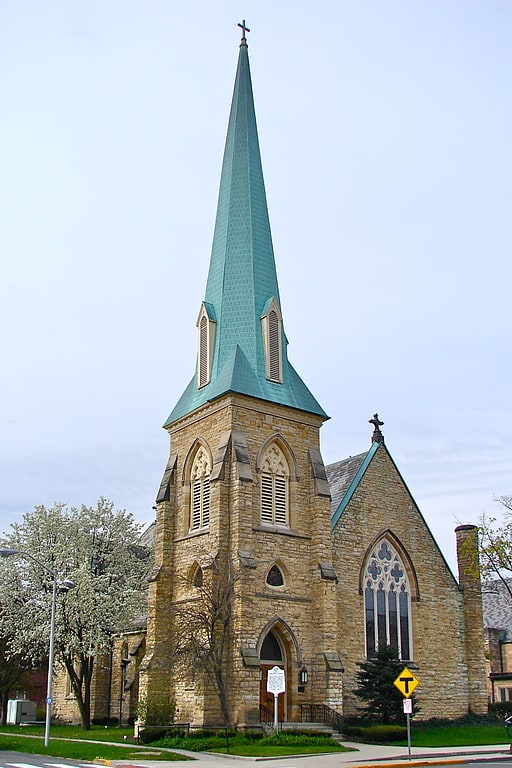
Episcopal church in Fort Wayne, Indiana. Trinity Episcopal Church is a historic Episcopal congregation and church, designed by Toledo, Ohio architect Charles Crosby Miller and constructed ca. 1865 in Fort Wayne, Indiana. The congregation was organized in 1839 as Christ Church and the name changed in 1844 to Trinity Church. The first church was built on the northwest corner of Berry and Harrison Streets in 1850. It is an example of Gothic Revival architecture.
It was listed on the National Register of Historic Places in 1978.[33]